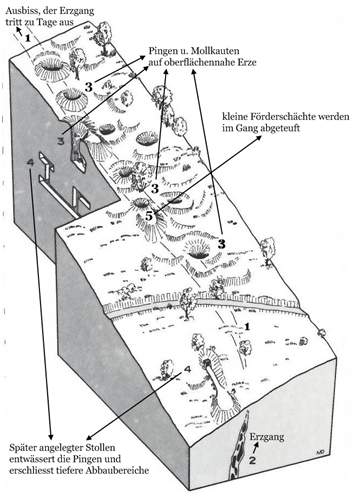Previously ore was dug off from the surface. Later, the miners had to go deeper and deeper to follow the lode. Therefore they constructed fault pits and mine shafts to reach the ore lodes. Penetration of water and the hauling itself were big problems and thus many pits had to be closed down. It was not unitl tunnels and modern pumping-works could be built that mining became possible in large depths.
Sources: M.Döring (Ferndorf): “Eisen und Silber, Wasser und Wald“, Verlag die Wielandschmiede, Kreuztal
Mining at the region of Eisernhardt was first documented in 1495. We know that Gerhardt Lutener von Isern was the first owner of a mine. But relicts of medieval and Celtic smelting (as of 500 BC) were found in the region of Eisernhardt, too, and it seems that the beginning of mining here was the ”Old Sinter Pit”. Till today numerous cavities can be seen on both sides of this path in the forest soil. They are signs of surface mining in shallow hollows, fault pits and shafts. Many hidden legacies of ancient mining are not recognized as such but are misused as waste deposit and filled up by and by. So most of those historic marks are hidden or even destroyed in our days.




